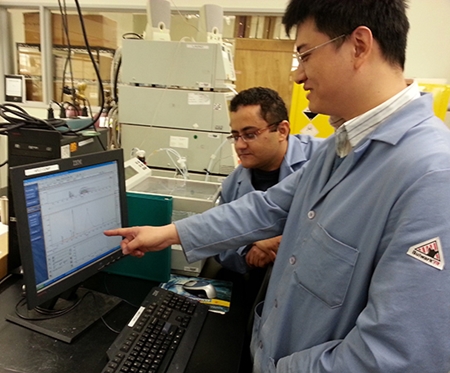
Science graduate student Amgad Albohy and post-doctoral fellow Yi Zhang are part of Chris Cairo's (PhD) team who have discovered new inhibitors to be used in cancer research.
It turns out that some of the biological tricks used by the flu virus are important for understanding a range of serious health problems we are trying to solve. A new discovery by University of Alberta Faculty of Science researchers may help us learn more about these mechanisms-helping to generate new therapeutics for cancer and inflammatory disease.
The U of A team, led by Dr. Chris Cairo, a scientist in the Alberta Glycomics Centre and an Associate Professor of Chemistry at the U of A, have made a breakthrough in understanding some of the communication processes that occur between cells and viruses and between cells themselves.
"The drugs we use to combat the flu target a particular enzyme in the virus called neuraminidase (NEU). These drugs inhibit the enzyme the virus uses to grab hold of cells, and particularly, the handle on the cell surface that it uses-known as sialic acid. We're looking at how this process is involved in other diseases, by looking at how our own cells use sialic acid in biological processes, like when cells stick together or come apart," explains Cairo. The flu and human cells have this process in common-and it looks like these enzymes may play an important part in our understanding of cancer and inflammation.
These cellular mechanisms are highly complex-and Cairo and his team have been working on finding new compounds that will target the human enzyme family, of which there are several members. Finding compounds that are effective and selective all at once is a real challenge- "It's hard enough to make the right new compound, but to find one that is active and that discriminates between four different enzymes that are extremely similar can be an even bigger challenge," Cairo emphasizes.
In their most recent paper, the group has found compounds that are highly effective for a single member of the enzyme family, and that are also active enough at low enough concentrations to be tested in animals. The U of A team is collaborating with a group at the University of Montreal to look at the activity of their new compounds in mice. The two groups have published their most recent results on neuraminidase inhibitors in ACS Medicinal Chemistry Letters and the Journal of Medicinal Chemistry.
*This story originally appeared in Faculty of Science News.